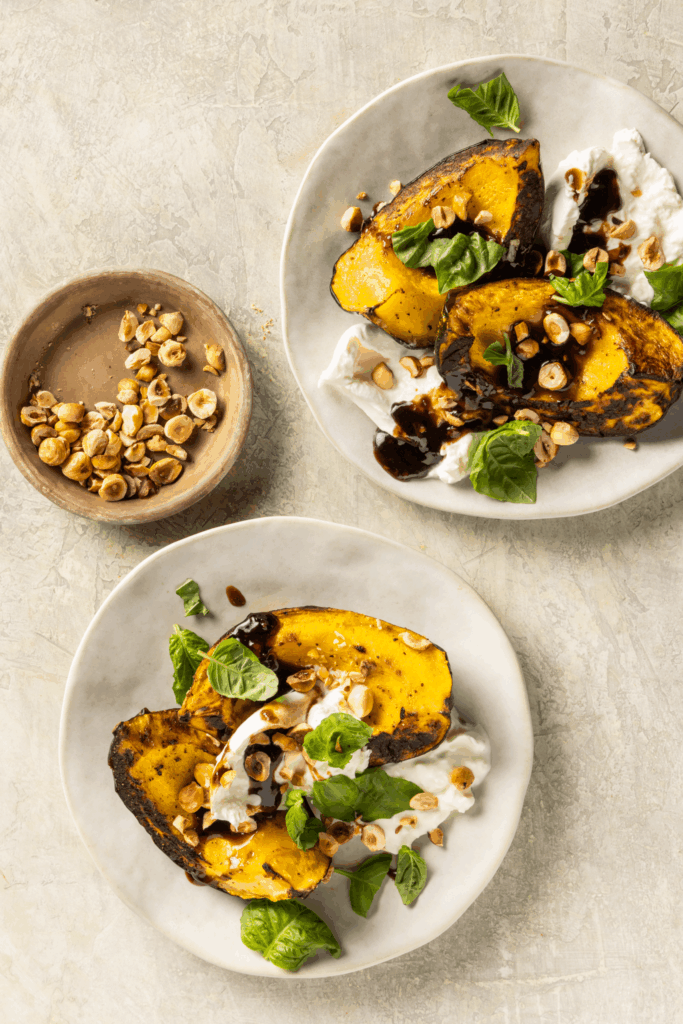
The Science Behind Sweet–Sour Magic
If there’s one dish that captures fall on a platter, it’s this Roasted Squash Agrodolce with Burrata—a recipe I recently developed for my role as Editor-in-Residence at America’s Test Kitchen. It’s sweet, tangy, creamy, nutty, and deeply aromatic… basically everything I love about colder weather.
The full recipe lives on ATK (link below!), but I want to walk you through the science, history, and technique behind the dish so you understand why it works so well—and how the classic Italian condiment agrodolce transforms humble ingredients into something truly special.
What Is Agrodolce? A Quick History
“Agrodolce” comes from two Italian words: agro (sour) and dolce (sweet).
It’s a centuries-old Sicilian condiment traditionally made by reducing vinegar and sugar with aromatics like garlic, onions, and sometimes herbs or dried fruit.
Historically, agrodolce was a way to preserve vegetables, fish, and even meats by coating them in a syrupy sweet–sour glaze. Over time, it evolved into a standalone sauce used to finish dishes—think:
- roasted vegetables
- grilled meats
- whole fish
- sautéed greens
- even polenta and cheeses
Modern variations often incorporate honey, wine, dried chilies, raisins, pine nuts, or fruit. My version leans on balsamic glaze, honey, rice vinegar, and anchovies to create a deeper, more savory balance in this Roasted Squash Agrodolce with Toasted Hazelnuts and Burrata.
The Science of Agrodolce: Why Sweet + Sour Works So Well
Agrodolce is more than a flavor combination—it’s a sensory equation rooted in chemistry.
1. Sweetness amplifies aromatic molecules
Honey and balsamic glaze contribute fructose and sucrose, which enhance our perception of aroma. The sweetness lifts the natural caramel notes of roasted squash.
2. Acidity sharpens flavor
Unseasoned rice vinegar introduces acetic acid. Acidity brightens food by stimulating saliva production, which carries flavor compounds more efficiently across your palate.
3. Heat boosts volatility
When the glaze simmers, aromatic molecules in garlic, shallots, and red pepper flakes become more volatile—meaning they reach your nose faster. This is why agrodolce smells as good as it tastes.
4. Anchovies = Umami foundation
Anchovies cook down into a base rich in glutamates. They don’t make the sauce taste “fishy”; instead, they deepen the savory backbone and round out the acidity.
Why Balsamic Glaze Works Better Than Balsamic Vinegar
In this recipe for the Roasted Squash Agrodolce with Burrata, the starting point is balsamic glaze, not regular balsamic vinegar. Here’s why:
Reduced viscosity
Balsamic glaze is essentially balsamic vinegar that has already been reduced. This cuts down on stovetop time and delivers a syrupy, glossy texture that clings beautifully to squash.
Concentration of flavor
Reducing balsamic vinegar intensifies its grape must sugars, producing notes of fig, caramel, and dried fruit. Starting with a glaze means you begin with those concentrated flavors already built in.
Better emulsification
The thicker texture helps the sauce emulsify effortlessly with the olive oil and honey, giving it a velvety mouthfeel.
How Roasting Squash Enhances Flavor (The Maillard + Caramelization Tag Team)
At 475°F [245°C], two reactions transform acorn squash:
1. Maillard browning
The cut surfaces contain amino acids and natural sugars. At high heat, these molecules react to create new, deeply savory and toasty flavors.
2. Caramelization
Squash contains sucrose and glucose. As it roasts, these sugars break down, contributing nuttiness and sweetness.
Roasting the squash on the lower-middle rack places it closer to the heating element, which accelerates browning—giving you more flavor in less time.
Why You Add the Burrata After the Squash Cools
This step matters more than you’d expect:
- Burrata’s creamy center contains fat and proteins that start to melt above ~90°F (32°C).
- Placing it onto hot squash causes it to separate into oily pools.
- Adding it to room-temperature squash preserves its lush, cool-cream texture and contrasts beautifully with the tangy agrodolce.
It’s one of those little technique moments that makes the dish feel restaurant-worthy with almost no effort.
Texture Matters: Why Hazelnuts Work So Well Here
Hazelnuts bring:
- crunch
- warm, roasted nuttiness
- a contrast to the soft squash and creamy cheese
Their natural oils intensify during toasting, releasing aromatic aldehydes and pyrazines. These compounds pair exceptionally well with balsamic acidity and sweet squash.
Putting It All Together
This dish hits every sensory note:
- sweet (honey, balsamic glaze, roasted squash)
- sour (rice vinegar)
- creamy (burrata)
- crunchy (hazelnuts)
- savory (anchovies, shallots, garlic)
- herbal (basil)
The final drizzle of agrodolce ties everything together in this Roasted Squash Agrodolce with Burrata with a glossy, aromatic finish that’s balanced and bright.
Get the full recipe here on America’s Test Kitchen
If You Make This Roasted Squash Agrodolce with Burrata and Loved It…
Tag me (@abrowntable on Instagram) —I love seeing your kitchen experiments and how you bring these flavors to life. And if you want more deep dives into the science of cooking, flavor building, or pantry staples like balsamic glaze, join my newsletter for weekly food science stories.

